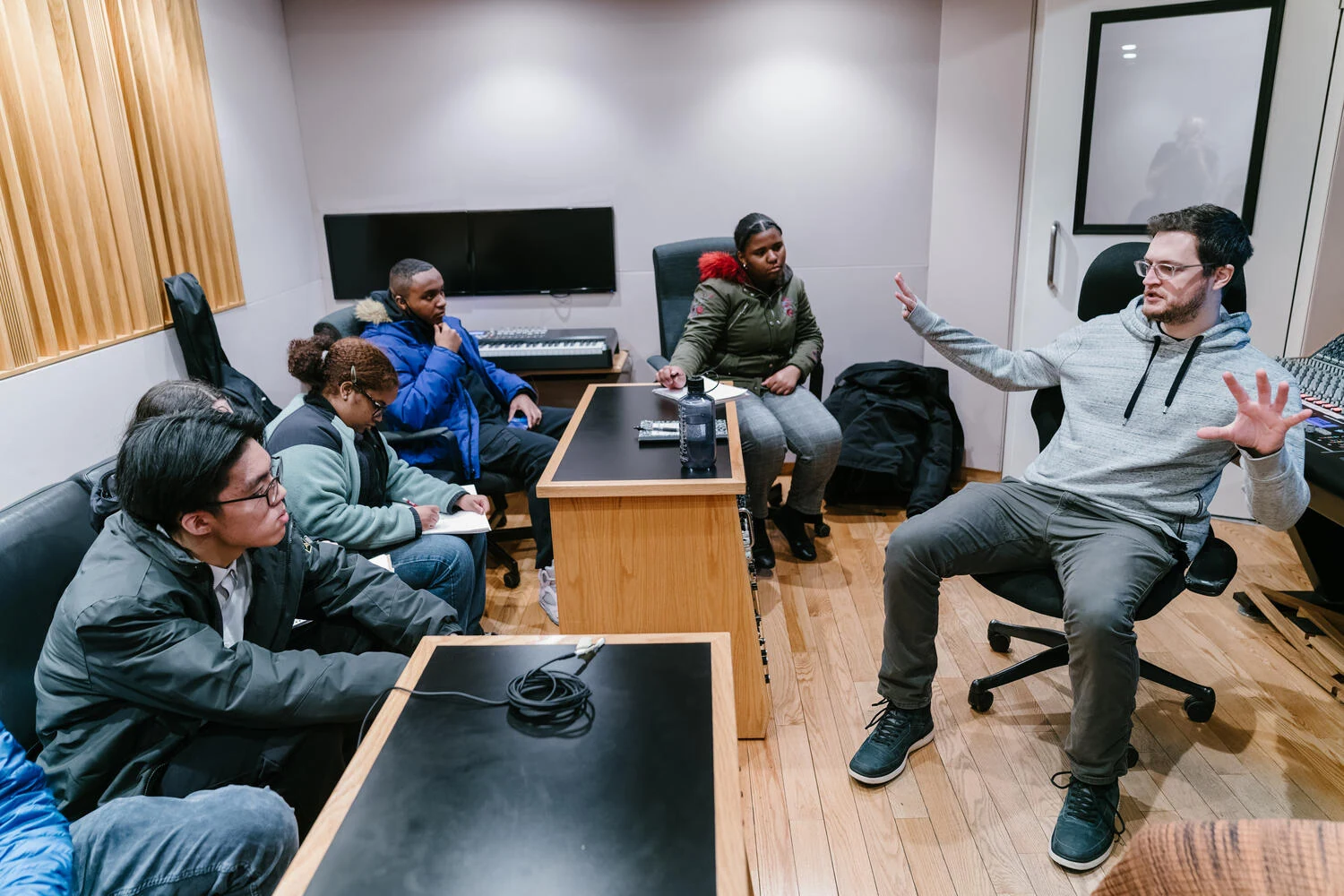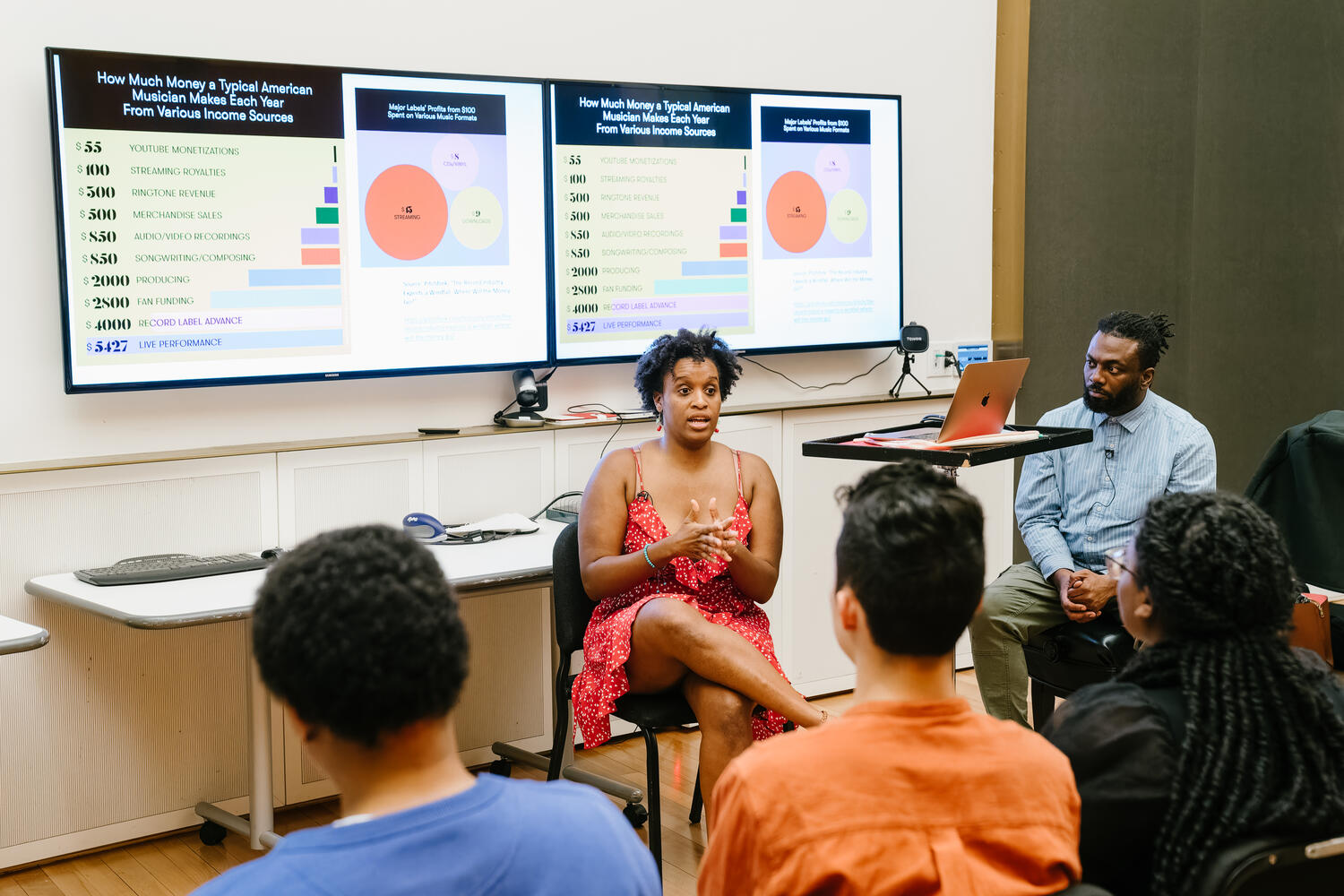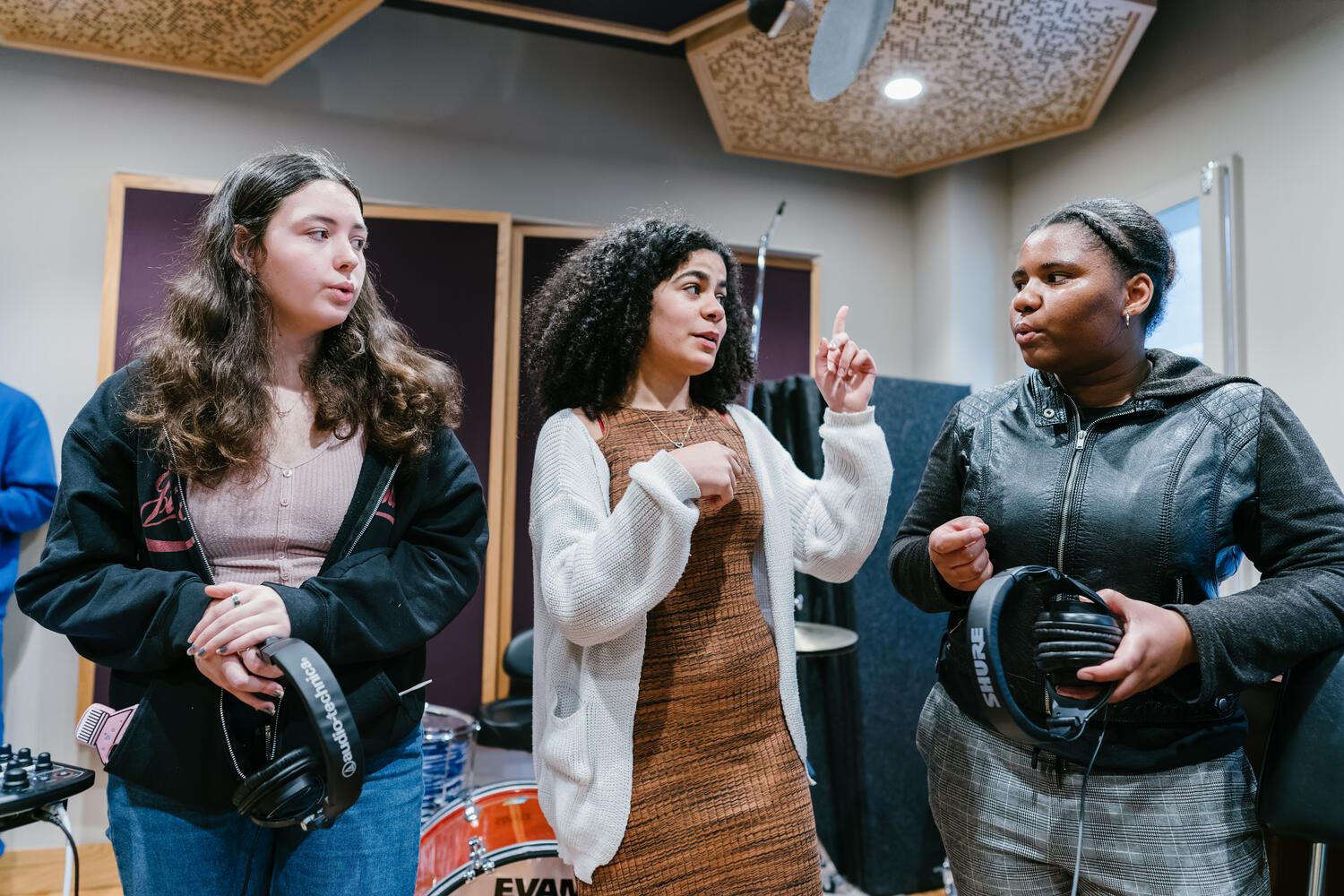When Bri Bernard was invited to a training program at the legendary Carnegie Hall in New York City last year, she was excited to finally visit “this landmark of great music.” And not just to visit but to “work in the space where so many wonderful artists performed.”
“Once you step inside,” Bernard says, “it’s even cooler.”
Carnegie Hall’s The B-Side is helping young New Yorkers between the ages of 14 and 22 explore career pathways in the music industry, and Bernard is exactly the kind of student The B-Side hopes to attract: a woman of color who grew up in the Bronx, had never been to Carnegie Hall before and is seriously invested in composing and producing music.
Over the course of a week, she and 39 other young aspirants visited the Louis Armstrong Museum and recording studios, learned from entertainment lawyers, union reps and musicians, and got feedback from professionals on their work. “I think it’s important to share our knowledge with the next generation of entrepreneurs, artists and producers,” says Donald Garner, one of the popular program facilitators, whom the students all affectionately call “Dr. G.” “Research and anecdotal evidence tells us about the lack of representation young people have, especially people of color, in terms of breaking into the industry.”
The highlight for Bernard was visiting Stanley Brown’s Pulse Music Studio in Midtown Manhattan. “It was my first time working in a truly professional studio,” she says. “That was simply awesome.”

Though Bernard plays the piano and the bass, The B-Side does not specifically target musicians but rather young people curious about a career in music more broadly. “The unifying factor for young people in the program is their love of music regardless of which career they’re interested in,” says Ayanna Cole, the director of Carnegie Hall’s Social Impact Programs. Students range from performers who have already released their first single to people who are still figuring out what they want to do.
The B in B-Side stands for business. The students learn about contracts, royalties, marketing and other crucial aspects of the industry. While the program’s goal is not to produce music, “there is a break room where we simply leave instruments out, and before five minutes are over, one has picked up the bass and another is at the piano and the vocalist jumps on the microphone,” Cole has observed. “Creating music together creates a different kind of community for them.”
Crushed by negative news?
Sign up for the Reasons to be Cheerful newsletter.
Bernard is one of 40 trainees who were selected for the week-long pilot in the spring of 2023, and the program was so popular it has since been expanded into a four-month afterschool program with ideas for expanding it even further next year. “We really considered research around the lack of diversity in the music industry,” Cole says. She speaks of a “diversity desert where underrepresented groups are abundant on the charts, but quite underrepresented not only on the C-suite level, but in artist management and other management executive levels across the industry.”
Cole refers to a 2021 study by USC Annenberg that examined the rank of over 4,000 executives across 119 companies in the music industry and found only three top executives were Black. While nearly half (46.7 percent) of all artists across 900 popular songs from 2012 to 2020 are from underrepresented groups, including 37.7 percent Black artists, the study found 100 percent of the top executives were white and only one was female when looking at the nine biggest music companies including Spotify, SME and Live Nation. “Put differently, there were 17.7 white male executives to every one Black female executive,” the study concludes. “Together, the results show that the music business has a workforce crisis on its hands, as the leadership ranks communicate to non-White individuals that they do not belong.”
In order to level the playing field, The B-Side students don’t have to pay for the training. Instead, Carnegie Hall gives them a $600 stipend to cover transport and other costs.
Carnegie Hall staff promotes The B-Side participants through community partners, including New York City’s child welfare agency and Probation Department. The esteemed Carnegie Hall already has over 14 years of experience presenting concerts and music programs in diverse spaces, including prisons, hospitals, senior care residences and schools as well as with people experiencing homelessness.

Crucially, The B-Side starts and ends with a class about power, gender and identity. “It’s important to learn about ways to keep yourself safe in any industry,” Cole remarks, “but in particular when you think about the ideocracy of the music industry with its big personalities and powerful celebrities.”
Cole herself came into this role as a former TV producer. She was an Emmy-award-winning producer at the History Channel for 11 years before she started a nonprofit to introduce underrepresented young people to media careers with a similar intention as The B-Side. “I was almost always the only woman of color on the production side, and I wanted to help level the playing field,” Cole says. Just like in the music business, “I realized that young people getting their foot in the door were often the director’s daughter or the producer’s son, and I wanted to help young people who traditionally didn’t know about careers in television to learn more about them.”
She first connected with Carnegie Hall as an applicant for one of their grants to community-based organizations and was a natural fit when the director position opened up nine years ago. She continues to be impressed “by the students’ maturity and the depth of their questions,” she says. “They ask questions like, ‘Were there times when you failed, and how did you overcome it? What are the things that helped you not to give up?’ They also ask a lot of quite advanced technical questions.”
One student felt so empowered by The B-Side she released her first single after the training. “The program helped me evaluate what I wanted to be and my goals, giving me the push to do my own single and release music,” the student says. Another credits the relationship he cultivated during the studio field trip with getting an artist he was working with signed with a label.
Cole purposefully also invites The B-Side participants’ parents — who might not necessarily see a career in music as a viable career path — to at least one in-person session at Carnegie Hall. “Particularly immigrant parents or parents of color sometimes struggle to achieve economic well-being,” Cole says. “It is important for the parents to know that there are lots of viable careers in the creative sector. You could become an entertainment lawyer or get a union position as a stagehand. It’s impactful for the parents, too, because they are part of the support system for the young person.”
Bernard appreciates the framework. “As a youth of color, it is super important to see yourself represented so that I am truly able to envision myself in these positions.” she says. “It’s often even more healing than hearing the words.”

Bernard is now 19 and a student in the fully funded First Wave Hip Hop and Urban Arts scholarship program at UW-Madison, Wisconsin.
The B-Side has already changed her trajectory: She switched her major from music composition to sociology because she wants to dig deeper into the research about structural inequality. Since beginning her freshman year, she has premiered her project Tales of Black Motherhood, where she shares recorded passages from Black mothers about their lived experiences, and she is currently producing music for a show called “Can a Song Be a Revolution?” where she mixes non-classical Indian music with hip-hop and jazz that will be paired with other arts to illustrate the similarities between the caste system and systemic racism in America. She focuses on “the ways that art intersects with activism and academics” and says she’s “excited to continue to work on various forms of artistic activism in the future.”
Bernard credits The B-Side with opening her mind to a wider range of possibilities. “The numerous opportunities to work in music that The B-Side showed me blew my mind,” she says. “Before coming into Carnegie, I believed that there was one way to make it in the industry and that was the path I had to follow. I have since encountered so many inspirational people and experiences that I wouldn’t have explored without the courage that The B-Side instilled in me.”
The post Carnegie Hall Is Helping Young People of Color Explore the Music Industry appeared first on Reasons to be Cheerful.




